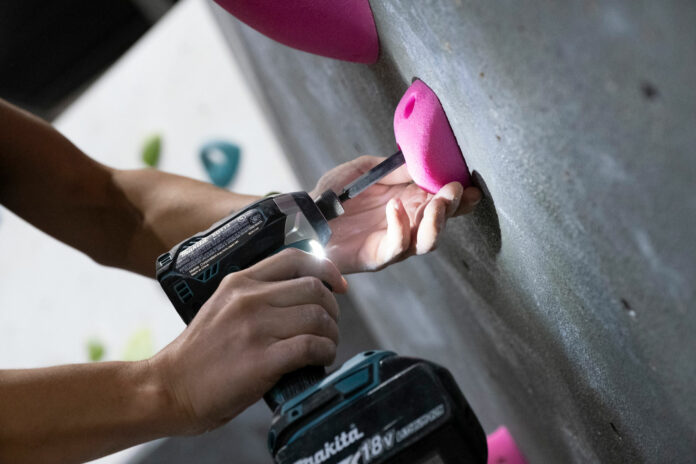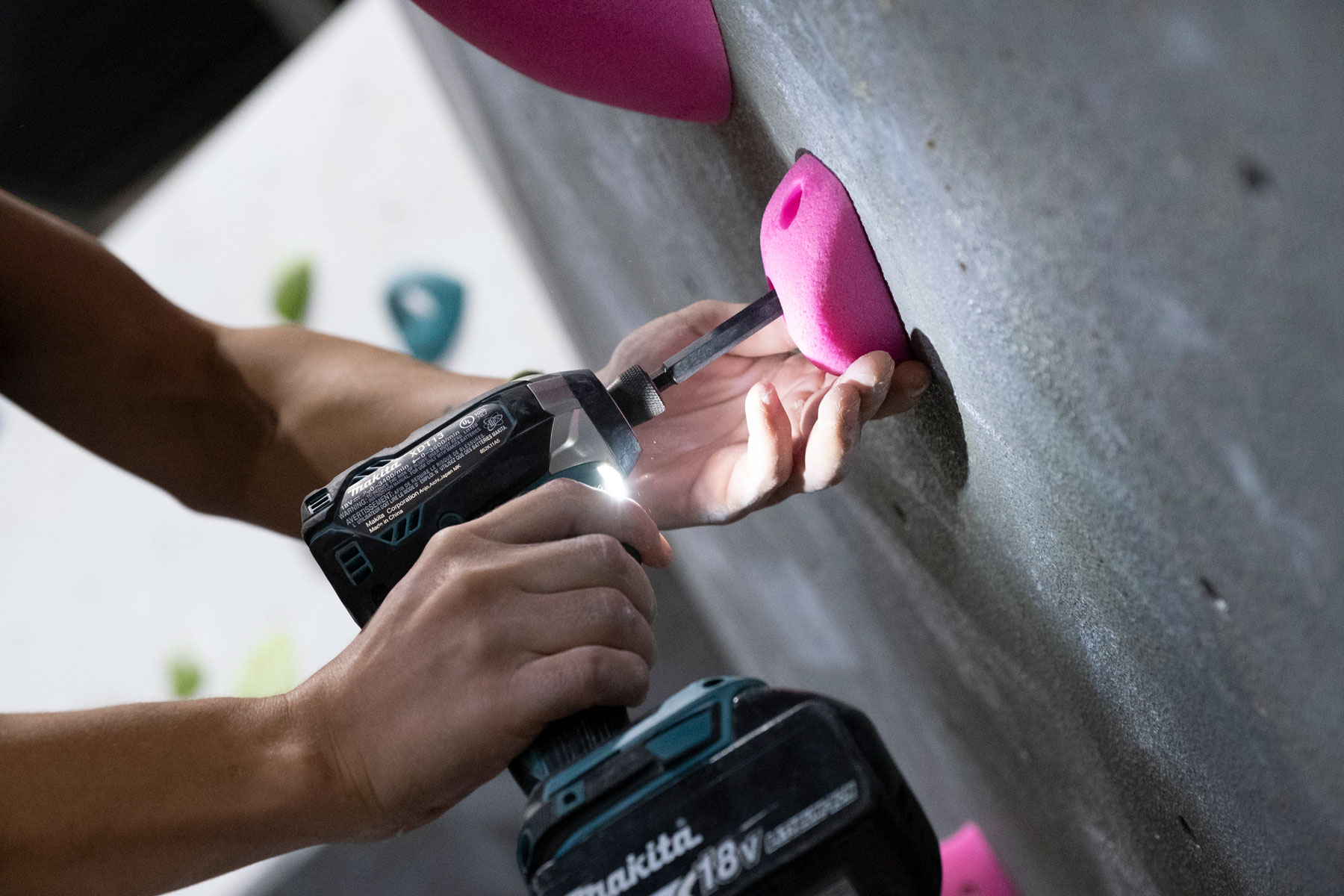
[Editor’s Note: This article was written by Jackie Hueftle, Joe Robinson and the CBJ editorial team as a companion to 9 Routesetting Essentials. In tandem, be sure to check out Essentials for Routesetting on Ropes, as well.]
There is arguably no single tool that is more emblematic of routesetting than an impact driver. More commonly referred to as a “drill” by setters, a Makita in the hands of a routesetter is like a Fender Strat in the hands of a rock star. But just as there isn’t one axe in your local guitar shop, there are multiple drills in hardware stores around the country and online, and choosing between all the options out there can feel daunting—especially if it’s your first gig.
In the climbing gym industry’s early days, routesetters strutting into the gym with their own kit was a mark of professionalism, like showing up for a job interview in suit and tie. The kit, at first, tended to be a few hand tools and maybe a waist pouch. In the past ten years, it has become more and more common for setters (especially traveling ones) to show up with their own rolling tool box, their own PPE (including harness and rigging gear for Work at Height), and their own tools and equipment—things like vice grips and breaker bars, extra jibs with extra screws, and (the most used tool) the impact driver. Some setters buy all this gear themselves, but for setters tied to a specific gym, the gym is now expected to provide these necessary tools to the setters on their team. This means you may find yourself trying to decide which kits to get for yourself or even for an entire crew.
There are several factors to consider when choosing the right drill for your situation, but we help break down the fundamentals below.
Power (12-volt vs. 18-volt vs. 20-volt)
Even though today’s 12-volt impacts have achieved greater power than their predecessors, they do have a few downsides, including noise (some are quite high-pitched) and general lack of power. Overall, the 12v driver shouldn’t be trusted to tighten holds properly in a commercial gym context. Instead, professional setters should opt for an 18-volt impact driver, which should cover all your needs in commercial setting environments. Some setters go for 20v drills instead, but the additional power isn’t necessary for setting and in fact can be too much for some walls. With responsible use, the choice mostly comes down to personal preference (usually brand preference, since the drills of some popular brands are more available in 20v rather than 18v).
These days there are a number of different 18v and 20v impact drivers available, including sub-compact, brushless and oil-impulse. Some impacts are available worldwide, while others are region specific.
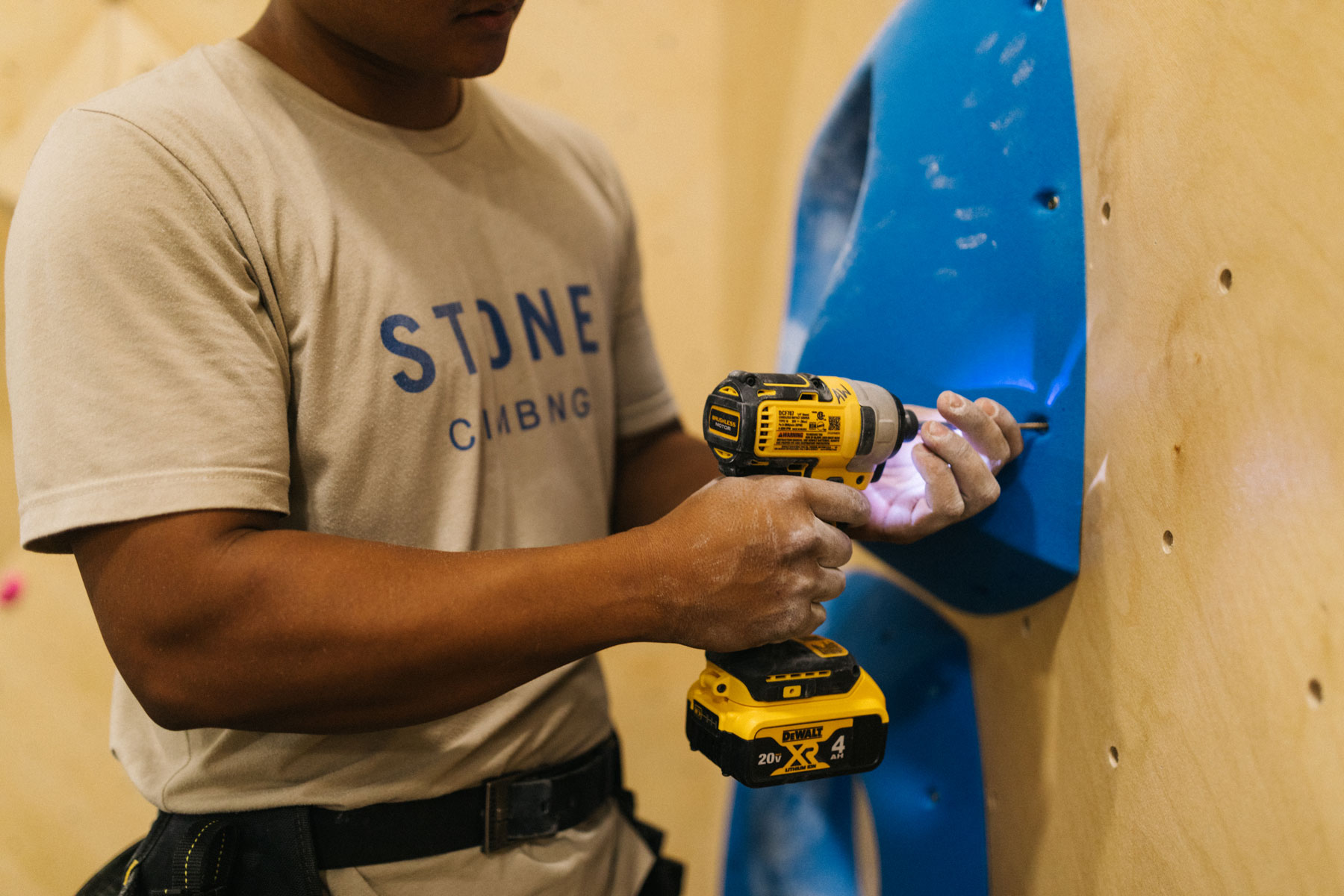
Size (Standard vs. Sub-Compact)
Each impact driver is slightly different in design, and the balance of the driver in the setter’s hand while working is very important. Sub-compact impact drivers are designed to be smaller, so they are generally lighter and easier to handle than standard impact drivers, although they can be more expensive.
When considering the size of your next impact driver, try to hold the driver (with a battery installed) in your hand and see how the balance feels to you. There are many unwieldy drill options out there but, for setting, the extra money for a good tool that you will be lifting regularly is well worth it.
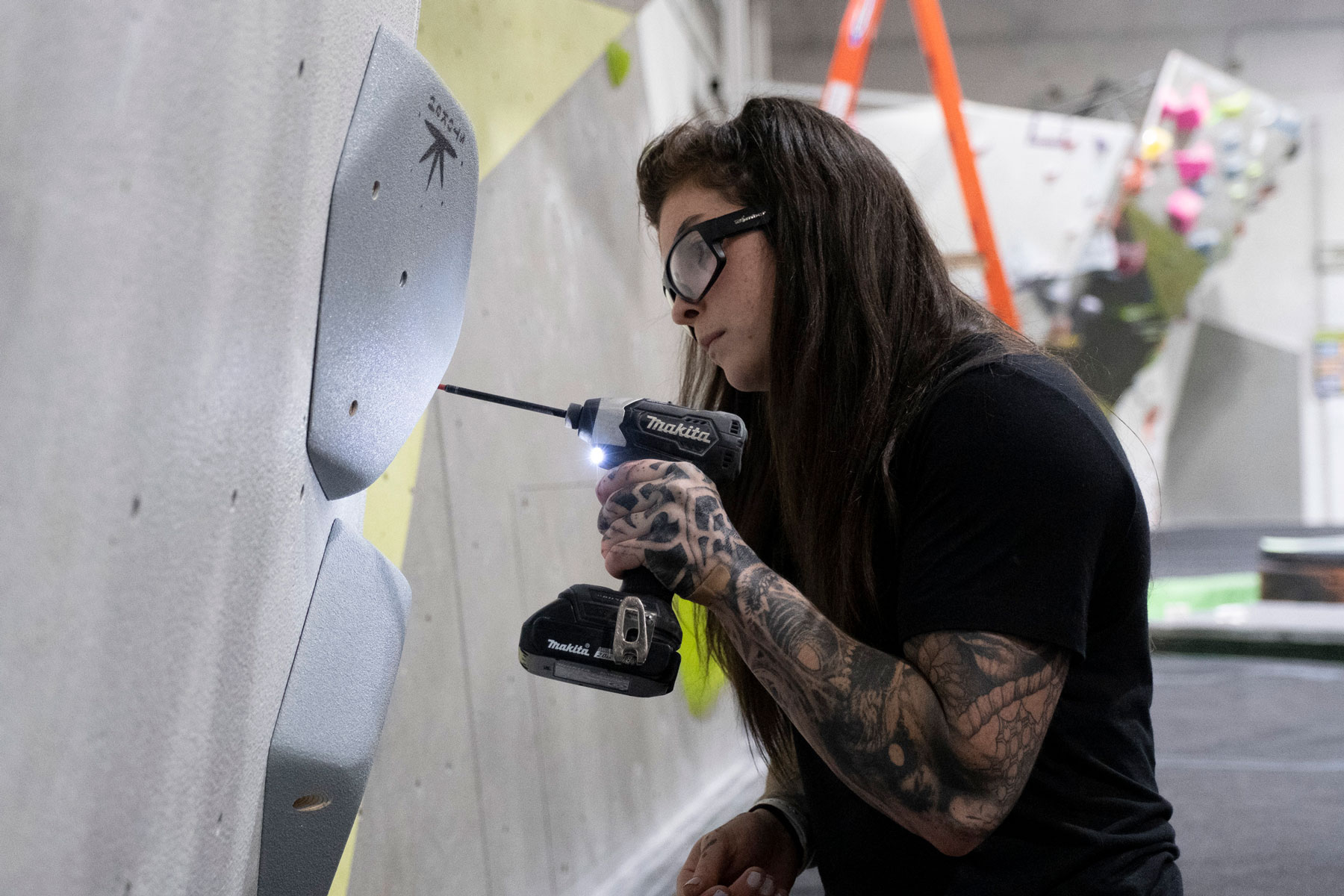
Motor Type (Standard Brushed vs. Brushless vs. Oil Impulse)
There are a lot of tech specs pertaining to different motor types, but for setting it comes down to predicted use and preference. Some points to keep in mind when choosing which motor you want your impact driver to be powered by:
Standard (Brushed) Motors
These motors use carbon “brushes” which transfer power to the rotors without creating sparks.
Pros: They are often less expensive than brushless and oil-pulse versions, cheaper/simpler to fix, reliable, and offer a high torque ratio.
Cons: Downsides include overheating, burn out (when the brushes need to be replaced), and less control over the amount of torque delivered. Also, noise—standard impact drivers are likely responsible for that loud driver sound you’re used to hearing in gyms on setting days.
Brushless Motors
These motors transfer power via a magnetic field and automatically adjust the torque delivery depending on the task at hand.
Pros: Low maintenance (won’t burn out or need replacement brushes), dissipate heat efficiently, easier to use correctly because the torque adjusts automatically, more efficient since they automatically optimize battery life, and generally quieter than standard brushed motors.
Cons: More expensive, and harder to fix if they do break.
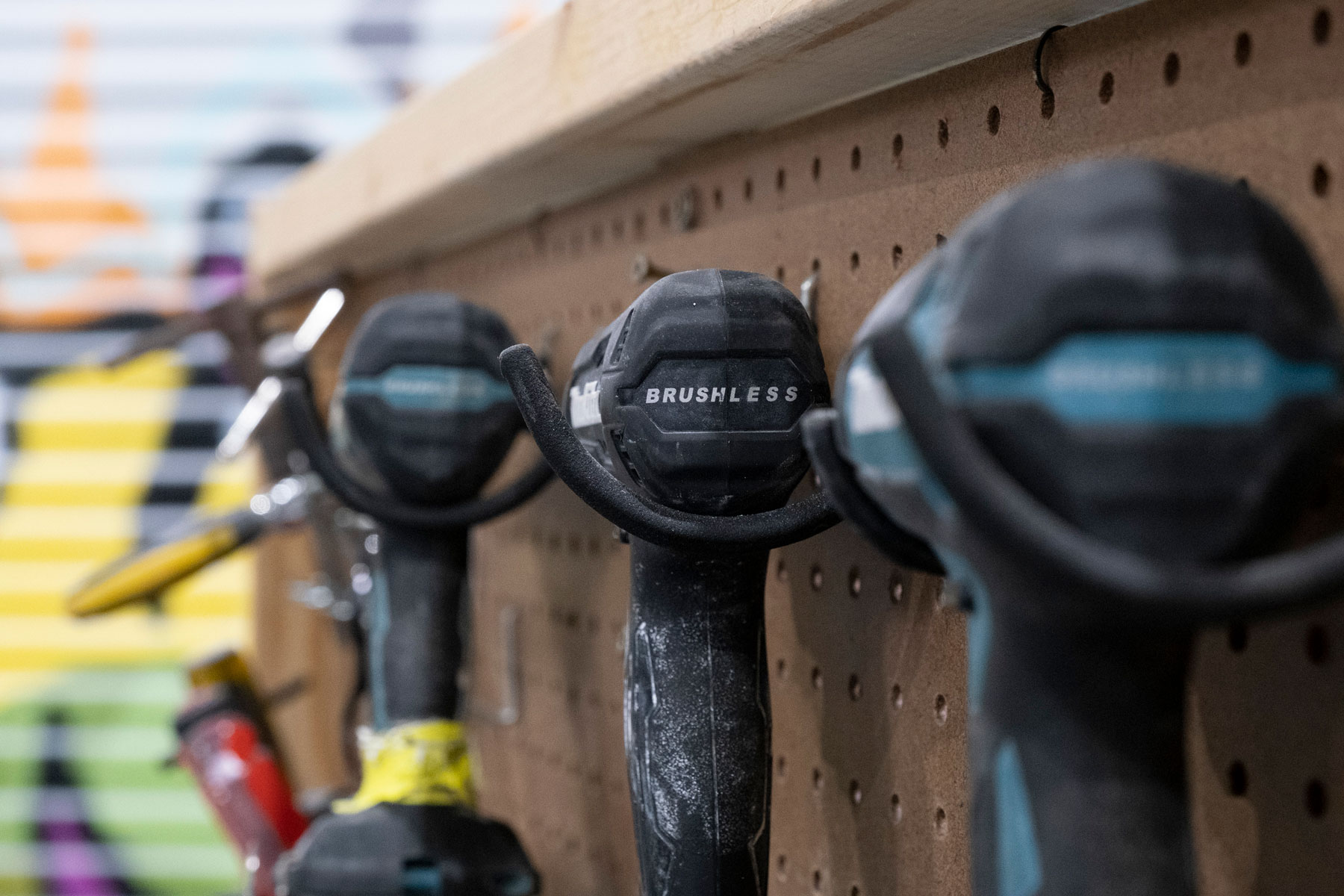
Oil Impulse
These motors have a viscous oil compartment that’s used to hydraulically drive the impact mechanism.
Pros: Quietest of the bunch, low vibration, light, nice to work with due to a soft-touch feel.
Cons: Most expensive and harder to use well—some believe the soft touch of an oil-pulse can actually make it harder to “feel” the t-nuts through the wall and can make it harder to tell if you’re cross-threaded. Oil-pulse users should therefore use caution until they’ve got their systems down. In addition, oil-pulse drills are not made for long stripping sessions, since long periods of reverse drilling can overheat the oil and burn the driver out (something we all have learned in the last few years after oil-pulses rose to popularity). At least one major oil impulse brand says their drill is not rated for the size of bolts we work with, and though some setters do use them and they do work ok, it’s important to note the drill’s capacity for tightening properly according to the manufacturer and make sure you’re getting your holds tight.
Imports
Different drivers are available in different regions of the world, and it is not uncommon for setters to import the personal kit driver they want from another country.
When considering specialty or imported impact drivers, one popular buy is the Japanese version of the Makita 18v. The Japanese Makita is even smaller than the U.S. version of the Makita sub-compact and is one of the most popular setting drills on the market amongst true nerds because it handles so well and can use the same batteries that you can get at any U.S. hardware store, plus there are several colors to choose from.
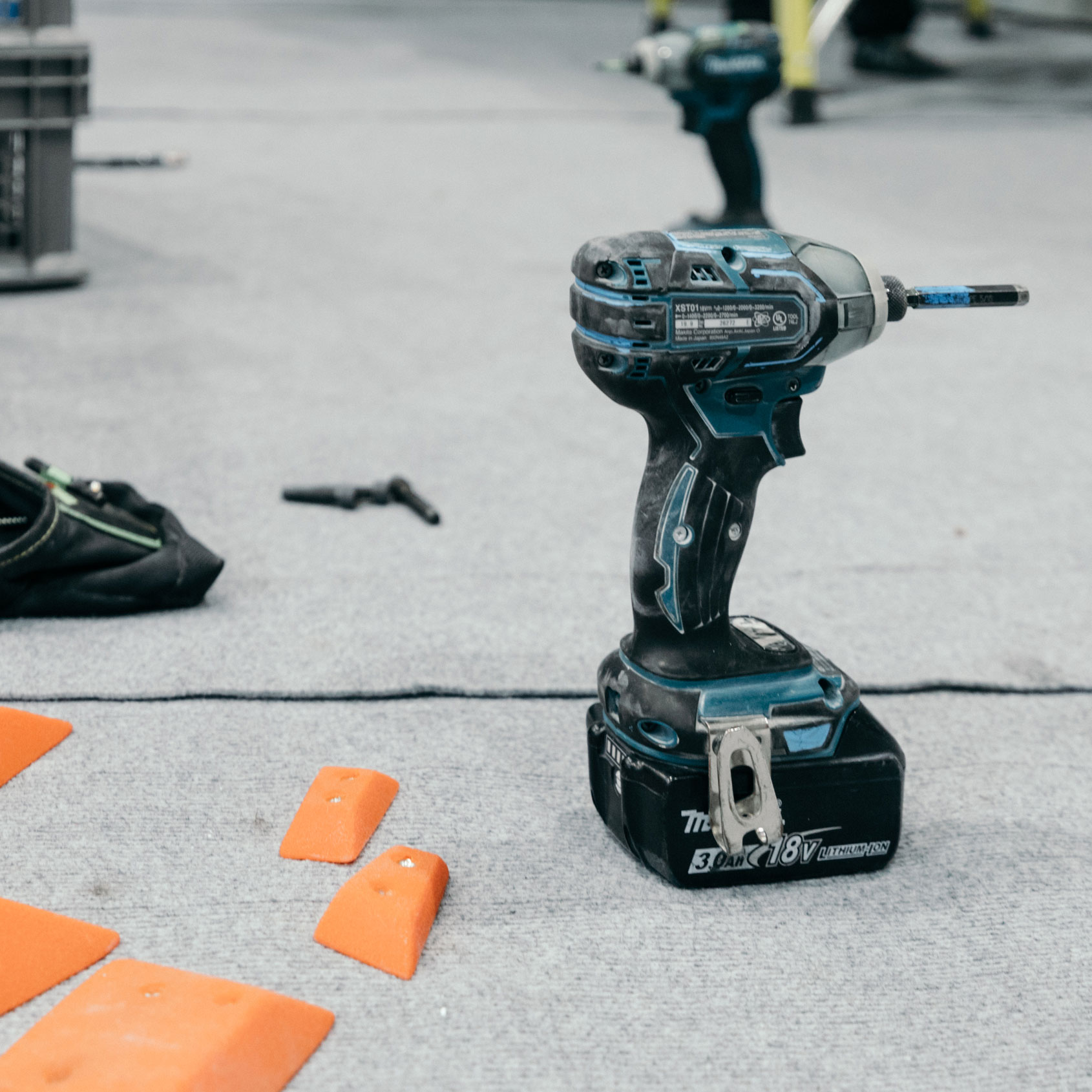
What should you buy for your program?
For gyms, the best setting department tool setups will be consistent; in other words, it’s best to buy your drivers as well as the other tools you need in the same system from the same manufacturer so that you can use the same batteries and chargers for your whole department. That said, this decision means you are committing to a system from one manufacturer, so be sure to look at all the tools you need to make sure they have options in the battery family you have chosen.
A universal system for your gym should not limit you too much, as most major brands have tool series that share the same size batteries, so you can get 18v or 20v drills, impact drivers, grinders, reciprocating saws, circular saws, etc., and share a few charging stations for all of them. If you do want to have a 12v kit handy for setting or other gym needs, some companies offer battery chargers that work for both 12v and 18v batteries, so you can have a few smaller tools on hand and still use your main charger system.
The next considerations then are price and weight. It is important not to cheap out here, as cheaper sets tend to be bulky, unbalanced and awkward, and those downsides will cause more problems in the long run for your setters. The price of many hardware store brand all-in-one kits is a good example of “you get what you pay for,” which may be fine for non-serious builders around the house but isn’t good for a commercial operation.
The best option for most programs will likely be brushless sub-compact systems because they are higher quality and hit the sweet spot for price, weight and noise. Some gyms will want a few oil-impulse drivers as well for setting during busy hours, but make sure you have some brushed or brushless impact drivers (with ear protection) on hand for stripping to avoid burning out your nice expensive tools.
Regardless of what system you choose, be sure to check for batteries and chargers at your local hardware store or another quick-delivery source, so that you know you can get them fast if you need them.

Jackie Hueftle is a founding member of the CWA Routesetting Committee and the Routesetting Institute. She has been setting since 1998, is USAC Nationally-certified Level 4, was Head Setter at The Spot, and is co-owner at Kilter Grips. In addition to Kilter she consults, teaches and sets for gyms and comps and contributes writing to national and international magazines.
 Joe Robinson has been working in the climbing industry for over a decade and currently manages CBJ advertising and editorial. He traveled the world as the IFSC’s community manager during Olympic inclusion and across the US while writing for Alpinist, Climberism, DPM and CBJ. He also worked in local climbing gyms of the Pacific Northwest and West Michigan while advancing economic empowerment, educational equity, youth development and diversity programs of national non-profit organizations.
Joe Robinson has been working in the climbing industry for over a decade and currently manages CBJ advertising and editorial. He traveled the world as the IFSC’s community manager during Olympic inclusion and across the US while writing for Alpinist, Climberism, DPM and CBJ. He also worked in local climbing gyms of the Pacific Northwest and West Michigan while advancing economic empowerment, educational equity, youth development and diversity programs of national non-profit organizations.




